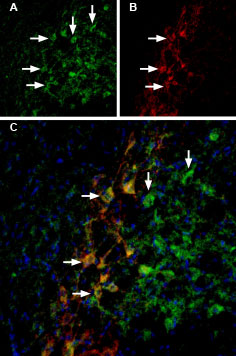Functional validation for peace of mind
Our pharmacological reagent portfolio is quite unique in that we test and show activity for new lots of each and every product. For each reagent we guarantee:
|
✓ Highly pure products |
|
|
|
Purity: >99% (HPLC) |
Alomone Labs (+)-MK 801 maleate inhibits NMDA (NR1+NR2A) channels expressed in Xenopus oocytes.
(+)-MK 801 maleate (#M-230)
|
|
Purity: >98% (HPLC) |
Alomone Labs ω-Agatoxin-IVA inhibits CaV2.1 currents heterologously expressed in Xenopus oocytes.
ω-Agatoxin IVA (#STA-500)
Novel tools for detecting ion channels
Innovation & Exclusivity
ATTO/Biotin-labeled peptide toxins
Studying membrane proteins, namely ion channels, remains a challenge due to the nature of their complex structure. Using the unique and exclusive properties of peptide toxins, we have developed a novel tool for detecting ion channels in living cells and tissues.
Benefits of using toxins labeled with ATTO or Biotin:
✓ Localization and distribution
✓ Clustering and internalization kinetics
✓ Live cell imaging
✓ Single cell detection
✓ Binding kinetics
Learn more about our novel probes for detecting ion channels
|
|
|
Drug discovery
Research interest in ion channels has without a doubt increased tremendously over the past few decades. Ion channels are important therapeutic targets in numerous pathophysiological conditions, from epilepsy, migraine, pain, neurodegenerative diseases, and heart conditions just to name a few. Venom-derived peptides have in turn been targeted by pharmaceutical companies as potential drugs due to their potency, selectivity, and safety (once isolated from venom).
In a joint effort, Alomone Preclinical Ltd. took part in the discovery, characterization and patenting of several toxins isolated from a number of tarantula venoms (Cherki, R.S. et al. (2014) Toxicon 77, 58.). GTx1-15 (#STT-300), VSTx-3 (#STT-350), Pterinotoxin-1 (#STT-100), and Pterinotoxin-2 (#STT-150) were all isolated as novel pain-related NaV channel blockers and may be used as tools to study the roles of the different channels in processes related to hyperexcitability and as lead compounds to treat pathological pain conditions.
Novel Toxins Novel Targets
As a result of being popular potential therapeutics, the rate at which new toxins are being unraveled has increased. With state-of-the-art technology in our facilities and keeping pace with newly published work we strive to deliver novel and exclusive ion channel modulators. SsTx Toxin (#STS-700), originally isolated from Scolopendra mutilans (Chinese red-headed centipede), is the first toxin isolated from the centipede venom and found to act as a KCNQ channel blocker. Coral snake venom is becoming a rich source of exciting new toxins such as MmTX1 Toxin (#STM-550), MmTX2 Toxin (#STM-600) modulators of GABA(A) receptors, and alpha/beta MitTx (#M-100) a novel ASIC1 channel activator.
Resources
| Novel Probes for Detecting Ion Channels |
FAQs | Magazines |





